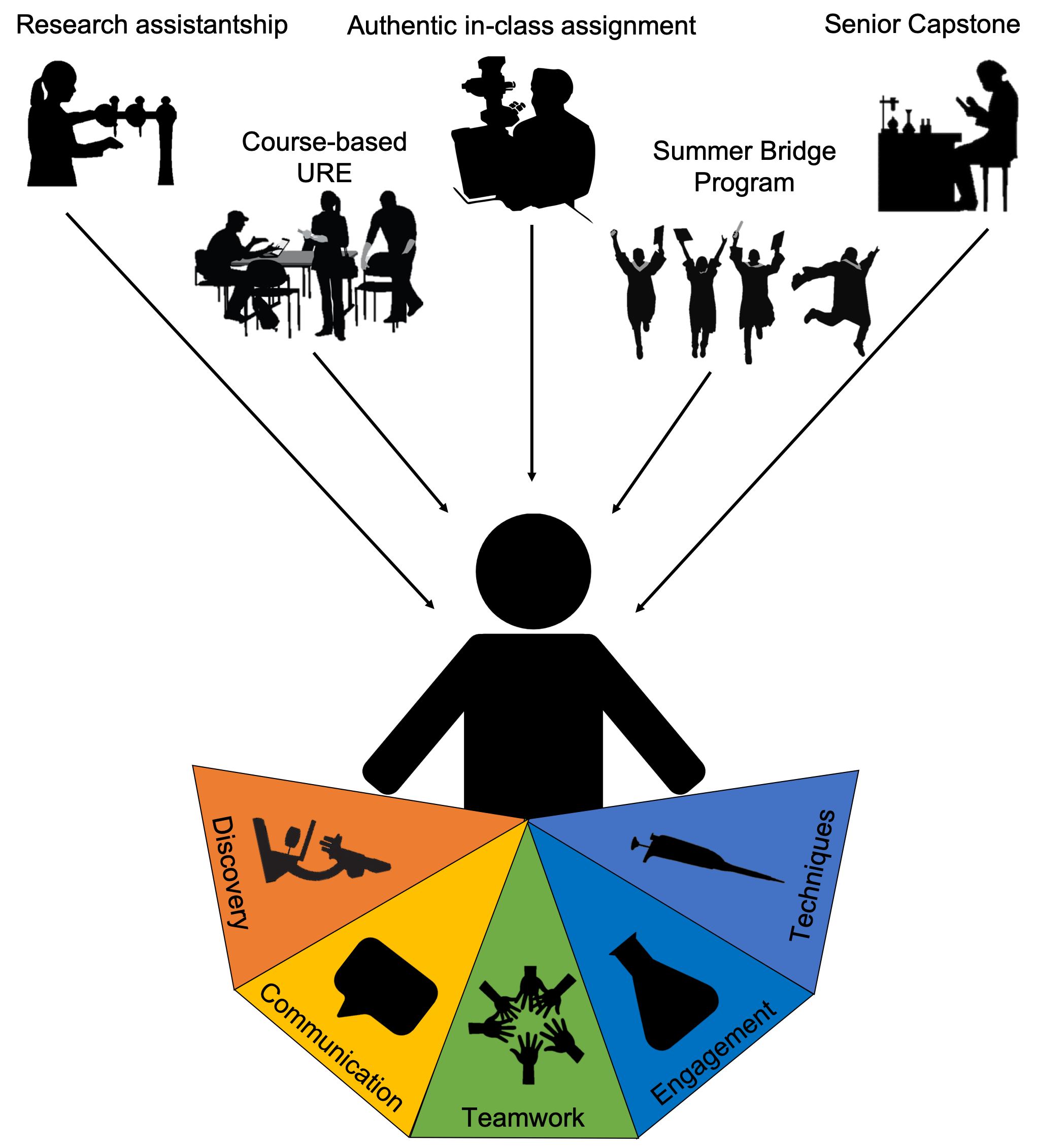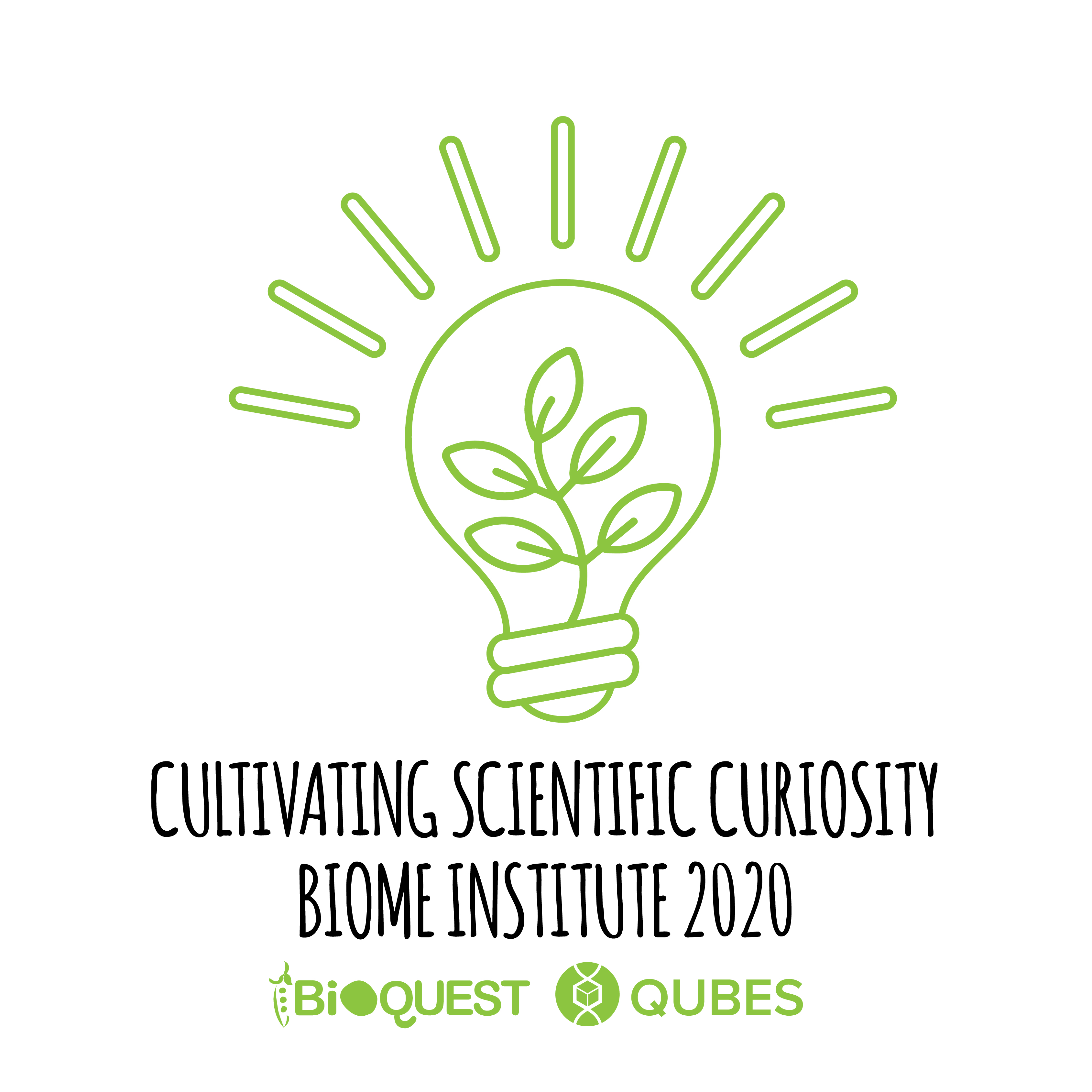Cultivating Scientific Curiosity
More on UREs
Examples | Background | Benefits | Detailed Examples
Undergraduate Research Experiences can be implemented in various forms and in all types of courses

Fig 1. Many different types of Undergraduate Research Experiences (URE’s) provide students transferable skills to prepare them for careers in STEM.
More on Undergraduate Research Experiences
The National Academies 2017 report, Undergraduate Research Experiences for STEM Students: Successes, Challenges and Opportunities, provides a broad definition of Undergraduate Research Experiences (UREs), acknowledging that no single program meets all of the following criteria but that a URE should meet several. In their definition, UREs should have some of the following characteristics:
-
They engage students in research practices including the ability to argue from evidence.
-
They aim to generate novel information with an emphasis on discovery and innovation or to determine whether recent preliminary results can be replicated.
-
They focus on significant, relevant problems of interest to STEM researchers and, in some cases, a broader community (e.g. civic engagement).
-
They emphasize and expect collaboration and teamwork.
-
They involve iterative refinement of experimental design, experimental questions, or data obtained,
-
They allow students to master specific research techniques.
-
They help students engage in reflection about the problems being investigated and the work being undertaken to address those problems.
-
They require communication of results, either through publication or presentations in various STEM venues.
-
They are structured and guided by a mentor, with students assuming increasing ownership of some aspects of the project over time.
(From NAP URE for STEM Students, 2017)
Included in this definition are apprentice-style faculty research group experiences, capstones and senior theses, internships and co-ops, CUREs, wrap-around experiences, bridge programs, consortium/project-based programs, and community-based research programs.
Mentoring is recognized as a key component of successful UREs, and there is evidence that it is important to provide appropriate training and support to mentors. A recent NAP report, The Science of Effective Mentorship in STEMM, discusses the role of mentoring and is supported by research and evidence from training programs.
References:
National Academies of Sciences, Engineering, and Medicine. 2017. Undergraduate Research Experiences for STEM Students: Successes, Challenges, and Opportunities. Washington, DC: The National Academies Press. https://doi.org/10.17226/24622.
National Academies of Sciences, Engineering, and Medicine. 2019. The Science of Effective Mentorship in STEMM. Washington, DC: The National Academies Press. https://doi.org/10.17226/25568.
American Association of Community Colleges. 2020. Community College Undergraduate Research Experience Summit Report. (https://www.aacc.nche.edu/wp-content/uploads/2020/04/AACC_URE_REPORT-FINAL.pdf)
Benefits of UREs include:
Increase Participation & Retention of STEM Students
- Participation in STEM courses (for nonmajors)
- Retention in STEM major
- Continued enrollment and/or graduation/degree completion
- Enrollment in graduate education
- Confirmation/clarification of career path
- Develop STEM literacy
Promote STEM Disciplinary Knowledge & Practices
- Learn content information
- Develop skills/techniques
- Understand concepts/research questions
- Know importance of iteration
- Appreciate value of teamwork
- Reflect on one's work
- Utilize disciplinary research practices:
- Ask questions and define problems
- Develop and use models
- Plan and carry out investigations
- Analyze and interpret data
- Use mathematics and computational thinking
- Construct explanations and design solutions
- Engage in argumentation from evidence
- Obtain, evaluate, and communicate information
Integrate Students into STEM Culture
- Increase interest in STEM field
- Promote agency and develop STEM identity
- Increase ownership of project
- Become enculturated or socialized into STEM community
- Commit to the discipline
- Act professionally
- Perform work as collaborative member of team
- Develop a sense of belonging/inclusion
- Recognize and overcome stereotype threat
(NAP UREs for STEM Students, 2017)
|
URE Type |
Description |
Examples |
|
Apprentice-style faculty research group experiences |
Students working under the supervision of a faculty member either during or outside the academic year |
Student(s) work as individuals on a research project, Research Experiences for Undergraduates (REUs) |
|
Authentic in-class assignments |
Learning outcomes are centered on the nature and process of science. Much of the research base is around active learning opportunities that emphasize scientific reasoning but do not involve doing original research. Sometimes labeled research-like problem solving. |
Science, Technology and Society Curriculum Overview Science, Technology, and Society MIT Open Courseware Science, technology, society and environment education Research Case Studies |
|
Capstones and senior theses |
Culminating experience that engages seniors within a major to apply and evaluate the knowledge they have gained over their undergraduate career |
Survey of Biology Capstone Courses, Haave, 2015 |
|
Internships and co-ops |
Typically paid positions where an individual works within an industrial or corporate environment. |
Federal and Industry Internships (eg NIST Internship Program) |
|
Course-based Undergraduate Research Experiences (CUREs) |
Class, large group or programs that offer research for academic credit during the academic year or over multiple academic years within a specific course that explores a novel research question. CUREs tend to replace traditional lab courses. |
|
|
Wrap-around experiences |
Span across several semesters or years to support underrepresented students navigate their major by providing research experiences, tutoring, and opportunities to build a community with their peers. |
|
|
Bridge programs |
Extended orientation to support student transition into four-year institutions or graduate programs. Students work individually or in teams for a short duration (< 1 year) outside the academic year. |
McNair, Building Better Bridge Programs into STEM, Ashely et al 2017 |
|
Consortium/project-based program |
Faculty-student collaborations across different institutions on a multidisciplinary project across multiple semesters. |
HHMI Exceptional Research Opportunities Program Leadership Alliance |
|
Community-based research programs |
Service-learning courses where the results of the research benefit the community. Students work with a community partner to design and implement research projects. |
Great Lakes Innovative Stewardship through Education Network (GLISTEN) |
